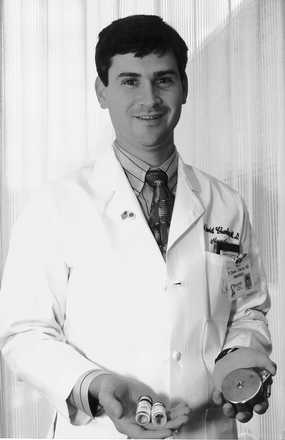
Dr. David Charles holds two examples of the therapies available at VUMC's new Spasticity Clinic. On the left is the neurotoxin Botox. On the right is a device that, after surgical implantation, releases medication to specific areas.
New spasticity clinic centralizes treatment options
Vanderbilt University Medical Center has opened a special clinic devoted to treating patients suffering from spasticity – a debilitating condition where muscles in the arms or legs lock involuntarily.
The new Spasticity Clinic at Vanderbilt offers a full range of treatments for spasticity, which is often caused by brain or spinal cord injuries but can also be caused by diseases of the brain such as cerebral palsy, multiple sclerosis, brain tumors, and strokes.
Until now patients with spasticity had to go to several different places in order to get the treatment they needed. The Spasticity Clinic consolidates and centralizes treatment, bringing together physical therapists, rehabilitation therapists, orthopaedic surgeons and neurosurgeons who can perform any procedure that a person with spasticity needs, said Dr. P. David Charles, assistant professor of Neurology.
"We can treat anyone with spasticity from any cause. Now, they can be assessed and treated in one clinic."
Spasticity, whether caused by trauma or disease, can be extremely painful, making even simple tasks such as getting dressed a nightmare for those afflicted due to the uncontrollable stiffening of the affected muscles.
"Cerebral palsy alone affects half a million Americans a year. This clinic is a giant leap for spasticity treatment around the country," said Charles.
The clinic is offering several new ways of treating spasticity.
For treatment of spasticity in multiple limbs, a new pump has been approved for implantation in patients which accurately targets anti-spasticity drugs to affected areas. The device, a hockey puck-shaped medication receptacle, is surgically implanted beneath a patient's stomach. The implantation surgery is performed by Dr. Bennett Blumenkopf, associate professor of Neurosurgery, who runs a line from the device to the patient's spinal column, delivering the medication where it's needed most.
"This is a unique route for delivering medication. Once you develop a multidisciplinary approach, like the one at the Spasticity Clinic, you availa yourself of a number of other opportunities that you had not anticiapated," Blumenkopf said.
This medication is a non-addictive drug that inhibits the nerves which make the muscles spasm. The drug has been in use for years in an oral preparation.
"What is new is the delivery system," Charles said. "To take it by mouth a patient had to take about 80 milligrams per day. With the pump, patients only need to take 200 micrograms because you are delivering it right to where it needs to be."
When taken orally, the drug's side effects include drowsiness. With the pump, however, the decreased dosage virtually eliminates drowsiness.
The pump also eliminates the roller coaster aspects of oral medications. When patients take medication several times per day, medication levels in the blood stream rise and fall.
"That's all right for antibiotics, but for a drug that determines a patient's ability to move, the level of medication has to be really smooth. The implant allows us to give them a smooth, steady drip of medication," said Charles.
A computer chip in the pump regulates the flow of medicine into the patient's spinal cord. Each time a patient comes to the spasticity clinic the pump is checked to determine the rate of flow and can be adjusted if the patient needs more or less medication.
"One of the great things about this pump is that to adjust it we do not have to operate again, we can just reset the amount of medication," Charles said. "The patient doesn't even have to take a shirt off. To refill the medicine in the pump, we just insert a needle into a port built into the pump and put more medicine in."
Another treatment being used at the spasticity clinic is administration of the drug Botox, which has been used on stroke victims with spasticity in one localized area.
Botox is one of the most potent neurotoxins on earth and is more powerful and concentrated than the most poisonous snake or insect venom known to science. One milligram is enough for several hundred patients.
Small injections of this drug in the muscle have to be precisely guided with the diagnostic help of EMG (electromyography), which pinpoints the exact area of the muscle responsible for the spasticity. Botox is then injected exactly to that area.
"The doses we are using only affect the muscle we inject," said Charles. "The drug affects only the nerve which controls that muscle, so it is very accurate."













